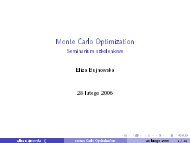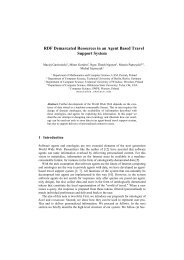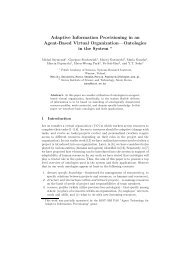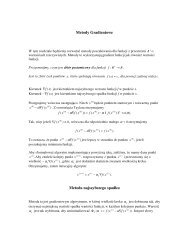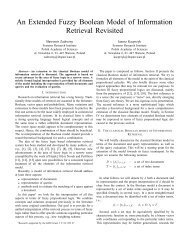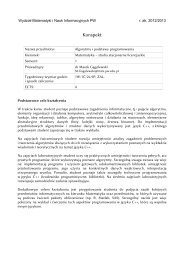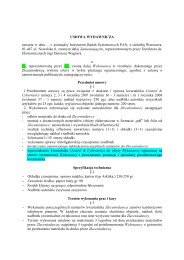Knowledge Management in an E-commerce System
Knowledge Management in an E-commerce System
Knowledge Management in an E-commerce System
Create successful ePaper yourself
Turn your PDF publications into a flip-book with our unique Google optimized e-Paper software.
<strong>Knowledge</strong> <strong>M<strong>an</strong>agement</strong> <strong>in</strong> <strong>an</strong> E-<strong>commerce</strong> <strong>System</strong> 32. Keep<strong>in</strong>g a physical store open 24 hours a day is expensive proportional to the amount of revenue it generates. An e-<strong>commerce</strong> system, on the other h<strong>an</strong>d, c<strong>an</strong> run non-stop with very little extra overhead. However, however, thisrequires the process of knowledge m<strong>an</strong>agement to be <strong>an</strong> un<strong>in</strong>terrupted one. In st<strong>an</strong>dard <strong>commerce</strong> it is possible toexecute <strong>an</strong>d <strong>in</strong>corporate the results of knowledge m<strong>an</strong>agement functions while the “system” is offl<strong>in</strong>e / the stores areclosed, but this is not the case with <strong>an</strong> e-<strong>commerce</strong> system. It is even possible to envision a situation <strong>in</strong> which thereis no slower time at night, because the store is onl<strong>in</strong>e <strong>an</strong>d customers are active all over the world.3. Physical <strong>commerce</strong> is usually concerned with sell<strong>in</strong>g goods locally; even the largest multi-national are acclimated tofit the regions <strong>in</strong> which they operate. A successful electronic enterprise will, sooner or later, reach a truly globalscale, <strong>an</strong>d be forced to accommodate local differences <strong>in</strong> order to succeed <strong>in</strong> diverse markets. Because of this theamount of knowledge that the system must m<strong>an</strong>age <strong>in</strong>creases considerably, as knowledge about all local, culturalpeculiarities must also be ma<strong>in</strong>ta<strong>in</strong>ed. In addition, the overall picture of knowledge m<strong>an</strong>agement functions becomesa bit fuzzier <strong>in</strong> certa<strong>in</strong> situations: for example, a Europe<strong>an</strong> bus<strong>in</strong>essm<strong>an</strong> work<strong>in</strong>g <strong>in</strong> US may log <strong>in</strong> late at night to <strong>an</strong>operational center <strong>in</strong> Jap<strong>an</strong> (where it is already the next day), to order goods to be delivered to Europe (where it ismorn<strong>in</strong>g) to his family. In such a situation, knowledge acquisition functions become more complicated due to thefact that the customer, the “store” <strong>an</strong>d the recipient(s) are different <strong>an</strong>d reside <strong>in</strong> different countries <strong>an</strong>d time zones(this may, for <strong>in</strong>st<strong>an</strong>ce, make the conceptualization of knowledge acquisition more difficult).2.2 Differences for the userAs is obvious to <strong>an</strong>yone who has purchased onl<strong>in</strong>e, the user’s experience of e-<strong>commerce</strong> is paradigmatically differentth<strong>an</strong> that of traditional <strong>commerce</strong>. Some of these differences are very closely related to those discussed above, whileothers are tied to the nature of computer-hum<strong>an</strong> <strong>in</strong>teraction.1. Customers of traditional stores live primarily <strong>in</strong> the vic<strong>in</strong>ity of the store, visit it dur<strong>in</strong>g normal hours of operation,purchase items from a limited selection of the most <strong>in</strong>-dem<strong>an</strong>d commodities <strong>in</strong> a given area (e.g. kosher food <strong>in</strong> NewYork, car battery heaters <strong>in</strong> Fairb<strong>an</strong>ks) <strong>an</strong>d are attached to a particular regularly visited store. As argued above, thisis not the case <strong>in</strong> e-<strong>commerce</strong> “stores”. Here customers c<strong>an</strong> come from <strong>an</strong>y place <strong>in</strong> the world. They are attached toa br<strong>an</strong>d name of “store” (such as Amazon.com), not a physical location, they are served 24/7/365 <strong>an</strong>d they expect tof<strong>in</strong>d <strong>an</strong>yth<strong>in</strong>g that they are look<strong>in</strong>g for. The knowledge m<strong>an</strong>agement related effects of these requirements have beendescribed above.2. One of the more import<strong>an</strong>t differences that affects the customer behavior is the presence or lack of a hum<strong>an</strong>salesperson [3, 28]. To be able to overcome this difference a number of knowledge based personalization techniqueshave been <strong>an</strong>d are be<strong>in</strong>g developed [12, 20, 25, 26, 34]. For further discussion of personalization <strong>an</strong>d relationshipswith the customer, see [10].3. Clients expect that their experience of <strong>an</strong> onl<strong>in</strong>e store will be <strong>in</strong> l<strong>in</strong>e with the best of <strong>an</strong> ″Internet experience,” one <strong>in</strong>which <strong>in</strong>st<strong>an</strong>t gratification is the mode – <strong>in</strong>stead of search<strong>in</strong>g across a monster size Walmart, where almosteveryth<strong>in</strong>g c<strong>an</strong> be found, but it is unclear where it is hid<strong>in</strong>g. We need to remember that <strong>in</strong> <strong>an</strong> Internet store it is easyto provide the potential customer with very detailed <strong>in</strong>formation about product(s) <strong>an</strong>d service(s), as well as referencethe large amount of additional <strong>in</strong>formation available <strong>in</strong> a multitude of other, Internet-based, repositories. This delugeof <strong>in</strong>formation, while crucial to overcom<strong>in</strong>g the deficiencies of the system (e.g. lack of physical contact with thecommodities) c<strong>an</strong> also overwhelm the customer. This <strong>in</strong>dicates clearly that a number of import<strong>an</strong>t techniques basedon knowledge m<strong>an</strong>agement should be applied <strong>in</strong> order to filter the <strong>in</strong>formation <strong>in</strong>to <strong>an</strong> easily-comprehendiblepackage. Most of these techniques are related to the general concept of personalization as <strong>in</strong>formation filter<strong>in</strong>g:selection of the right sales support strategy, right <strong>in</strong>terface, right search support etc.4. There is still the problem of content delivery: customers who do not access the Internet through a fast enoughconnection to be able to receive high quality <strong>in</strong>formation. This limitation is especially import<strong>an</strong>t when we movefrom e-<strong>commerce</strong> to mobile <strong>commerce</strong> (m-<strong>commerce</strong>) <strong>an</strong>d from high quality computer displays to PDA/cell phonedisplays that c<strong>an</strong> deliver only low quality graphics, or no graphics at all. We must be able to actively applyknowledge about the physical <strong>an</strong>d process<strong>in</strong>g capabilities of display devices <strong>in</strong> order to regulate the form as well asthe content of the <strong>in</strong>formation delivered to the contents.5. Clients expect to feel <strong>an</strong>d rema<strong>in</strong> <strong>an</strong>onymous but also to be able to browse <strong>an</strong>d purchase what they are really<strong>in</strong>terested <strong>in</strong>, two <strong>in</strong>cl<strong>in</strong>ations that are often mutually <strong>in</strong>compatible <strong>in</strong> a traditional shopp<strong>in</strong>g scenario. In <strong>an</strong>International Conference on Electronic Commerce Research (ICECR-5)



